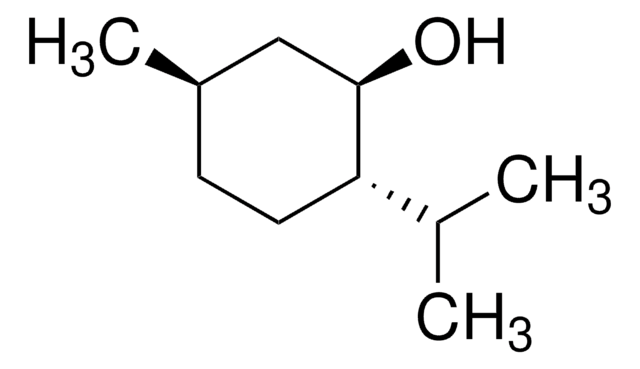W324507
Undecanoic acid
≥99%, FG
Synonym(s):
Hendecanoic acid
About This Item
Fragrance grade
Recommended Products
biological source
synthetic
Quality Level
grade
FG
Fragrance grade
Agency
follows IFRA guidelines
reg. compliance
EU Regulation 1223/2009
EU Regulation 1334/2008 & 178/2002
FDA
Assay
≥99%
bp
228 °C/160 mmHg (lit.)
248-250 °C (lit.)
mp
28-31 °C (lit.)
application(s)
flavors and fragrances
Documentation
see Safety & Documentation for available documents
food allergen
no known allergens
fragrance allergen
no known allergens
Organoleptic
creamy; waxy
SMILES string
CCCCCCCCCCC(O)=O
InChI
1S/C11H22O2/c1-2-3-4-5-6-7-8-9-10-11(12)13/h2-10H2,1H3,(H,12,13)
InChI key
ZDPHROOEEOARMN-UHFFFAOYSA-N
Looking for similar products? Visit Product Comparison Guide
Related Categories
General description
Application
- Undecanoic Acid and L-Phenylalanine in Vermiculite: Detection, Characterization, and UV Degradation Studies for Biosignature Identification on Mars.: This research focuses on the detection and characterization of undecanoic acid and L-phenylalanine in vermiculite, with potential applications for biosignature identification on Mars. The study also examines UV degradation, which is crucial for astrobiological research (McIntosh et al., 2024).
- Drugs Form Ternary Complexes with Human Liver Fatty Acid Binding Protein 1 (FABP1) and FABP1 Binding Alters Drug Metabolism.: This paper explores how drugs interact with human liver fatty acid binding protein 1 (FABP1), including the involvement of undecanoic acid, to form ternary complexes that influence drug metabolism. These findings have significant implications for pharmacology and drug development (Yabut et al., 2024).
- Enhancing antifungal and biocompatible efficacy of undecanoic acid through incorporation with chitosan-based nanoemulsion.: This study demonstrates the enhanced antifungal and biocompatible properties of undecanoic acid when incorporated into a chitosan-based nanoemulsion, highlighting potential biomedical applications for this compound (Sathiyaseelan et al., 2024).
- In Vitro Evaluation of Essential Oils and Saturated Fatty Acids for Repellency against the Old-World Sand Fly, Phlebotomus papatasi (Scopoli) (Diptera: Psychodidae).: This research evaluates the repellency of essential oils and saturated fatty acids, including undecanoic acid, against the Old-World sand fly. The findings provide insights into developing natural repellents for vector control (Temeyer et al., 2024).
Storage Class Code
11 - Combustible Solids
WGK
WGK 1
Flash Point(F)
>233.6 °F
Flash Point(C)
> 112 °C
Personal Protective Equipment
Choose from one of the most recent versions:
Already Own This Product?
Find documentation for the products that you have recently purchased in the Document Library.
Customers Also Viewed
Global Trade Item Number
| SKU | GTIN |
|---|---|
| W324507-5KG | 4061834405757 |
| W324507-100G | 4061835513550 |
| W324507-1KG | 4061834405740 |
| W324507-SAMPLE | 4061834405764 |
Our team of scientists has experience in all areas of research including Life Science, Material Science, Chemical Synthesis, Chromatography, Analytical and many others.
Contact Technical Service








